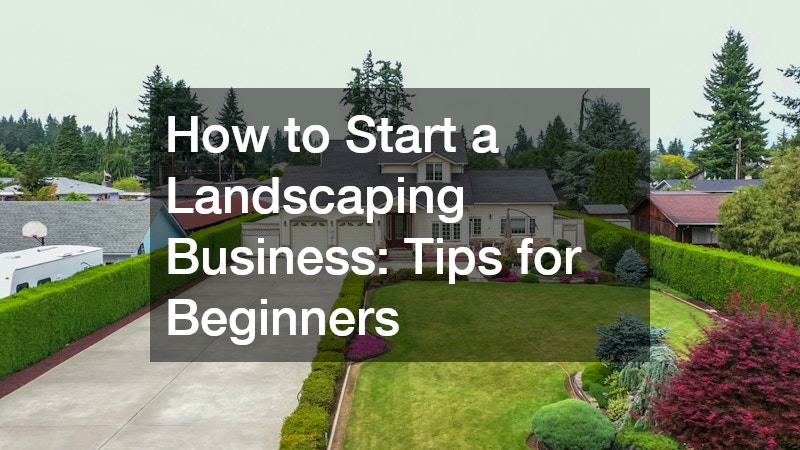Starting a landscaping business can be a rewarding venture for anyone who enjoys working outdoors and creating beautiful spaces. Landscaping combines creativity, hard work, and business skills, and it offers the opportunity to serve both residential and commercial clients. However, like any business, success requires planning, organization, and a clear understanding of the industry.
This guide covers everything you need to know to start a landscaping business, from initial planning and legal requirements to marketing, pricing, and growing your client base.
Step 1: Plan Your Landscaping Business

Before buying equipment or hiring staff, it’s crucial to plan your business carefully.
Define Your Services
Landscaping can include a wide range of offerings. Decide which services you’ll provide based on your skills, local demand, and budget:
- Lawn mowing and maintenance
- Planting and garden design
- Tree and shrub care
- Hardscaping (patios, walkways, retaining walls)
- Irrigation system installation and repair
Identify Your Target Market
Knowing your target audience will guide your pricing, marketing, and service offerings. Examples include:
- Residential homeowners
- Commercial properties (offices, retail, apartment complexes)
- Municipal or public spaces
Research Competitors
Look at local landscaping businesses to see what they offer, their pricing, and how they market themselves. This helps identify opportunities to differentiate your services.
Step 2: Register Your Business and Obtain Licenses
Starting a landscaping business requires proper legal setup to operate safely and professionally.
Choose a Business Structure
Common options include:
- Sole Proprietorship: Easiest and cheapest to set up, but personal liability is unlimited.
- LLC (Limited Liability Company): Protects personal assets and is a popular choice for small businesses.
- Corporation: More complex, usually for larger operations or those seeking investors.
Register Your Business Name
Pick a name that’s memorable and professional. Check your state and local databases to ensure it’s available.
Obtain Licenses and Permits
Requirements vary by state and city but may include:
- Business operating license
- Landscaping or horticultural license
- Pesticide applicator license (if applicable)
Get Insurance
Insurance protects you and your clients in case of accidents or property damage. Common types include:
- General liability insurance
- Workers’ compensation (if hiring employees)
- Equipment or vehicle insurance
Step 3: Purchase Equipment and Supplies

Having the right tools is essential for efficiency and quality service.
Basic Equipment for a Landscaping Business:
- Lawn mowers (push or riding)
- String trimmers and edgers
- Leaf blowers and vacuums
- Shovels, rakes, and hand tools
- Trucks or trailers for transport
Supplies You May Need:
- Fertilizers and soil amendments
- Mulch, plants, and seeds
- Irrigation components (hoses, sprinklers, drip systems)
Tip: Start small and grow your equipment collection as your business expands. You can also consider leasing or buying used equipment to reduce startup costs.
Step 4: Set Pricing for Your Services
Pricing your landscaping services correctly is one of the most important steps to ensure your business is profitable while staying competitive in your local market. Underpricing can lead to losses, while overpricing may drive potential clients to competitors.
Consider the Following Factors:
- Labor costs: Factor in not just your own time but also any employees’ wages, including benefits or overtime. Estimate how many hours a job will take and multiply by an appropriate hourly rate.
- Equipment and maintenance expenses: Landscaping requires tools and machines such as lawnmowers, trimmers, leaf blowers, and trucks. Account for the cost of purchasing, maintaining, and eventually replacing equipment.
- Materials: Include the cost of plants, mulch, soil, fertilizers, and any other consumables required for a project. Be sure to price materials at retail or wholesale rates, depending on your sourcing.
- Overhead: Don’t forget business expenses like insurance, fuel, marketing, office supplies, and software. These indirect costs should be spread across all your projects.
- Local market rates: Research what competitors in your area charge. Pricing too low can make clients question your professionalism, while pricing too high may reduce demand.
Pricing Models:
- Hourly rate: Ideal for smaller maintenance jobs like mowing, trimming, or simple cleanup tasks. Make sure to estimate the time accurately to avoid undercharging. For example, a typical hourly rate might range from $30–$60 depending on skill and local rates.
- Per project: Common for landscaping design, garden installation, hardscaping, or irrigation projects. Estimate the total cost of labor, materials, and overhead, then add a profit margin to determine a flat project fee. This makes billing predictable for clients.
- Monthly contracts: Great for recurring maintenance services such as lawn care, fertilization, or seasonal pruning. Clients pay a fixed fee monthly, providing steady cash flow for your business. Contracts also help with client retention.
Additional Tips for Pricing:
- Include a profit margin: Always add at least 15–25% above your costs to ensure your business remains profitable.
- Offer package deals: Bundling services, such as mowing plus fertilization, can attract clients and increase average revenue per customer.
- Be transparent: Clearly explain what’s included in your pricing to prevent misunderstandings. Clients appreciate transparency and it builds trust.
- Adjust for complexity: Some properties require extra work due to slopes, large areas, or difficult access. Price accordingly to avoid underestimating the effort involved.
By carefully calculating costs, understanding your market, and choosing the right pricing model, you can set rates that cover expenses, reward your effort, and remain appealing to clients. Pricing strategically is key to long-term sustainability and growth in the landscaping industry.
Step 5: Market Your Landscaping Business
Effective marketing helps you find clients and build a strong reputation.
Build a Brand
- Create a professional logo
- Develop a consistent look for uniforms, trucks, and business cards
Use Online Marketing
- Build a website showcasing your services, testimonials, and portfolio
- Optimize your site for local SEO to attract nearby clients
- Use social media (Instagram, Facebook, TikTok) to showcase before-and-after projects
Network Locally
- Attend community events and home shows
- Join local business organizations or chambers of commerce
- Partner with nurseries, garden centers, or real estate agents
Word-of-Mouth Referrals
Satisfied customers are your best marketing tool. Encourage reviews and offer referral discounts to expand your client base.
Step 6: Hire and Train Employees
As your business grows, you may need additional help.
Hiring Tips:
- Look for reliable workers with landscaping experience
- Offer training on company standards, safety procedures, and customer service
- Ensure employees have the necessary certifications if handling chemicals or specialized equipment
Safety and Compliance:
- Provide protective gear (gloves, safety glasses, boots)
- Train staff on equipment operation and hazard awareness
- Follow OSHA guidelines to prevent workplace accidents
Step 7: Manage Your Landscaping Business Efficiently
Efficient business management ensures smooth operations and long-term growth.
Scheduling and Job Management
- Use software or apps to schedule jobs, track clients, and manage billing
- Keep detailed records of materials used, hours worked, and expenses
Financial Management
- Separate personal and business finances
- Track income and expenses accurately
- Consider hiring an accountant or using accounting software for tax and bookkeeping needs
Customer Service
- Communicate clearly with clients about services, pricing, and schedules
- Handle complaints professionally and promptly
- Build lasting relationships to encourage repeat business
Step 8: Grow Your Landscaping Business
Once your business is stable, consider growth strategies:
- Expand Service Offerings: Add landscaping design, irrigation installation, or hardscaping services
- Offer Seasonal Services: Snow removal, fall cleanup, or holiday lighting
- Invest in Marketing: Paid advertising, online reviews, and social media campaigns
- Hire Additional Staff: Scale operations to handle larger projects and more clients
- Purchase More Equipment: Upgrade machinery to improve efficiency and take on bigger jobs
Challenges and How to Overcome Them
Running a landscaping business has challenges, but being prepared can help you succeed:
- Weather Dependence: Rain or extreme heat can delay jobs. Have a flexible schedule and communicate with clients.
- Competition: Offer unique services, maintain excellent customer service, and build a strong local presence.
- Cash Flow Management: Keep track of expenses and invoices, and consider contracts for recurring services.
- Physical Demands: Landscaping is physically intensive. Ensure you and your team follow proper ergonomics and safety practices.
FAQs About Starting a Landscaping Business
Do I need a degree to start a landscaping business?
No formal degree is required, but horticulture or landscaping courses can improve your skills and credibility.
How much money do I need to start?
Startup costs vary widely, from $5,000–$20,000, depending on equipment, licenses, marketing, and initial labor costs.
Can I start part-time?
Yes, many landscapers begin part-time to build a client base before scaling to full-time.
Do I need insurance?
Yes, general liability insurance and workers’ compensation (if hiring) are crucial for protection.
How do I attract clients quickly?
Leverage local advertising, social media, referrals, and partnerships with real estate agents or garden centers.
Conclusion
Starting a landscaping business combines creativity, hard work, and strategic planning. By carefully planning your services, obtaining licenses, investing in the right equipment, and marketing effectively, you can build a successful and profitable business.
Focus on providing high-quality service, maintaining excellent customer relationships, and managing operations efficiently. Over time, your landscaping business can grow from a small local operation into a thriving enterprise serving a wide range of residential and commercial clients.
Landscaping is not just about cutting grass — it’s about creating beautiful, functional outdoor spaces while building a sustainable business that can grow and thrive.


